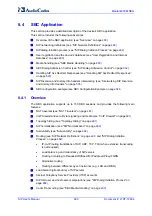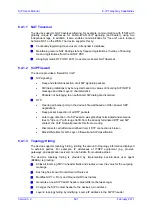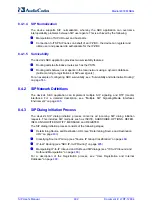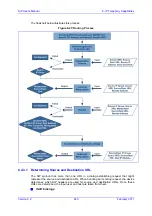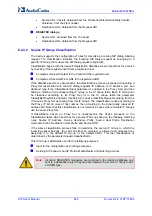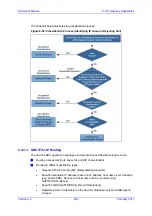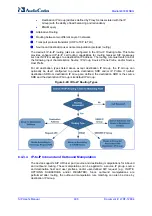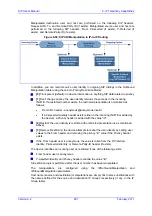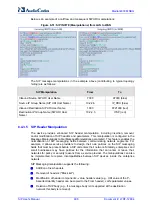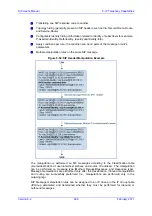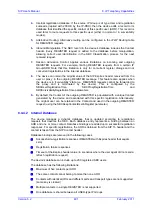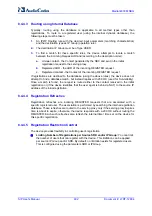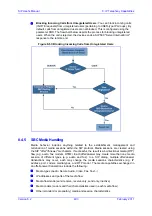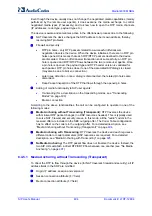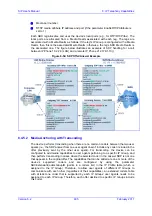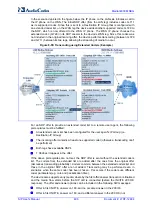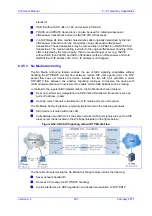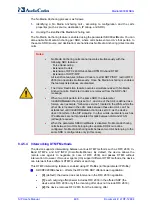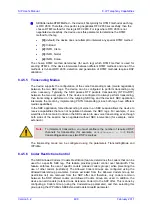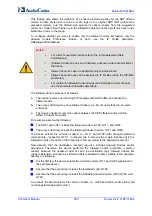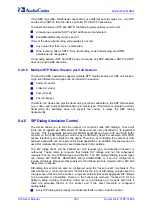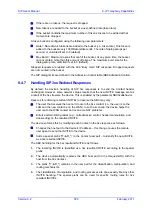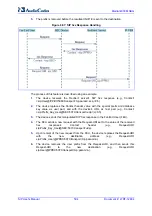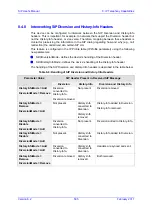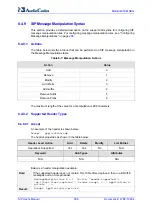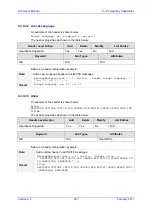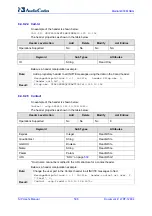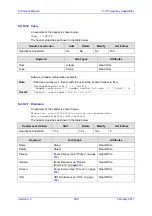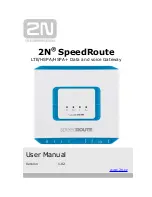
SIP User's Manual
494
Document #: LTRT-12804
Mediant 800 MSBG
Even though the device usually does not change the negotiated media capabilities (mainly
performed by the remote user agents), it does examine the media exchange to control
negotiated media types (if necessary) and to know how to open the RTP media channels
(IP addresses, coder type, payload type etc.).
The device is aware and sometimes active in the offer\answer process due to the following:
NAT traversal: the device changes the SDP address to be its own address, thereby,
resolving NAT problems.
Firewall and security:
•
RTP pin holes - only RTP packets related to a successful offer\answer
negotiation traverse the device: When the device initializes, there are no RTP pin
holes opened, this means that each RTP\RTCP packets destined to the device
are discarded. Once an offer\answer transaction ends successfully, an RTP pin
hole is opened and RTP\RTCP flows between the two remote user agents. Once
a pin hole is opened, the payload type and RTP header version is validated for
each packet. RTP pin holes close if one of the associated SIP dialogs is closed
(may also be due to broken connection).
•
Late rogue detection - once a dialog is disconnected, the related pin holes also
disconnect.
•
Deep Packet inspection of the RTP that flows through the opened pin holes.
Adding of media functionality to SIP user agents:
•
Transcoding (for a description on the transcoding modes, see ''Transcoding
Modes'' on page
)
•
Broken connection
According to the above functionalities, the call can be configured to operate in one of the
following modes:
Media Anchoring without Transcoding (Transparent):
RTP traverses the device
with minimal RTP packet changes (no DSP resources needed). This is typically used
to solve NAT, firewall, and security issues. In this mode, all the "audio" coders in the
received offer are included in the SBC outgoing offer. The Coder Table configuration
has no effect on the coders in the outgoing offer. For a detailed description, see
''Media Anchoring without Transcoding (Transparent)'' on page
Media Anchoring with Transcoding:
RTP traverses the device and each leg uses a
different coder or coder parameters (DSP resources are required). For a detailed
description, see ''Media Anchoring with Transcoding'' on page
.
No Media Anchoring:
The RTP packet flow does not traverse the device. Instead, the
two SIP UA's establish a direct RTP/SRTP flow between one another (see ''No Media
Anchoring'' on page
8.4.5.1 Media Anchoring without Transcoding (Transparent)
To direct the RTP to flow through the device (for NAT traversal, firewall and security), all IP
address fields in the SDP are modified:
Origin: IP address, session and version id
Session connection attribute ('c=' field)
Media connection attribute ('c=' field)
Содержание Mediant 800 MSBG
Страница 2: ......
Страница 366: ...SIP User s Manual 366 Document LTRT 12804 Mediant 800 MSBG Reader s Notes ...
Страница 372: ...SIP User s Manual 372 Document LTRT 12804 Mediant 800 MSBG Reader s Notes ...
Страница 390: ...SIP User s Manual 390 Document LTRT 12804 Mediant 800 MSBG Reader s Notes ...
Страница 404: ...SIP User s Manual 404 Document LTRT 12804 Mediant 800 MSBG Reader s Notes ...
Страница 616: ...SIP User s Manual 616 Document LTRT 12804 Mediant 800 MSBG Reader s Notes ...
Страница 636: ...SIP User s Manual 636 Document LTRT 12804 Mediant 800 MSBG Reader s Notes ...
Страница 652: ...SIP User s Manual 652 Document LTRT 12804 Mediant 800 MSBG Reader s Notes ...
Страница 886: ...SIP User s Manual 886 Document LTRT 12804 Mediant 800 MSBG Reader s Notes ...
Страница 890: ...User s Manual Ver 6 2 www audiocodes com ...

